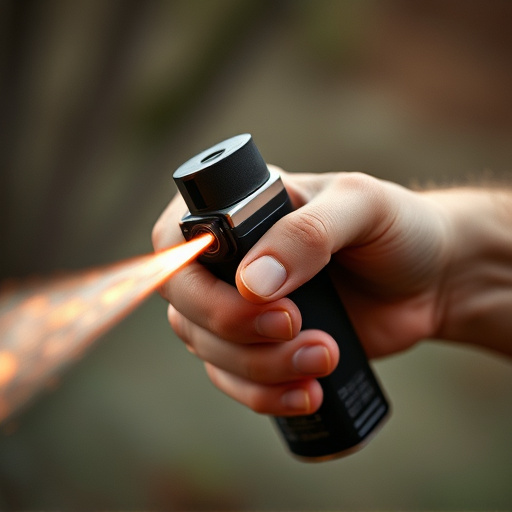Pepper spray, a common self-defense tool, temporarily impairs attackers by releasing capsaicin, with effects lasting from 20 minutes to an hour. Its effectiveness depends on concentration, application, and individual sensitivity. Contrary to myth, it doesn't cause permanent damage but offers users time to escape. Understanding its duration is vital for both individuals seeking self-defense and law enforcement using it strategically, highlighting the need for proper training, maintenance, and awareness of legal implications worldwide.
“Discover the power of pepper spray as a deterrent and its impact on personal safety. This comprehensive guide explores the science behind this non-lethal weapon, delving into its composition, activation mechanisms, and the intense physiological responses it elicits.
We dispel common myths about its duration of effect and navigate the legal considerations surrounding its use. Learn effective strategies to ensure its optimal deployment, providing a clear understanding of how long pepper spray truly affects the body—a crucial knowledge for anyone seeking self-defense.”
- Understanding Pepper Spray: Composition and Activation
- The Physiological Impact: How Pepper Spray Affects the Body
- Duration of Effect: Debunking Common Misconceptions
- Legal Implications and Effective Use Strategies
Understanding Pepper Spray: Composition and Activation
Pepper spray, a powerful deterrent and defense mechanism, is a compound designed to cause temporary yet intense irritation and disorientation in potential attackers. Its composition typically includes capsaicin, the same chemical that makes chili peppers spicy, along with other additives to enhance its effectiveness and duration. When activated, pepper spray releases this irritant into the eyes and respiratory system of the target, leading to a range of physical responses including tears, coughing, difficulty breathing, and pain.
The effects of pepper spray can last anywhere from 20 minutes to an hour, depending on various factors such as the concentration of capsaicin, the method of application, and individual sensitivity. This duration is crucial in providing users with enough time to escape or seek help during a threatening situation. Understanding how long pepper spray lasts ensures individuals are well-prepared and can make informed decisions regarding their safety when facing potential danger.
The Physiological Impact: How Pepper Spray Affects the Body
Pepper spray, a potent irritant, temporarily disables an attacker by affecting the eyes and respiratory system. When pepper spray comes into contact with the skin or is inhaled, it triggers a physiological response. The primary active ingredient, capsaicin, binds to pain receptors, causing a burning sensation and intense irritation. This leads to temporary blindness, reduced visibility, and difficulty breathing due to the constriction of airways.
The duration of pepper spray’s effects varies but typically lasts between 20 minutes to an hour. During this time, individuals affected may experience tears, coughing, sneezing, and difficulty standing or moving due to the intense irritation. The length of impact depends on factors such as the amount of spray used, weather conditions, and individual sensitivity. Understanding the physiological impact and how long pepper spray effects last is crucial for self-defense strategies and ensuring safety during potential attacks.
Duration of Effect: Debunking Common Misconceptions
Pepper spray, a common self-defense tool, has sparked many debates, one of which revolves around its duration of effect. There are numerous misconceptions surrounding how long pepper spray actually works, with claims varying widely. In reality, the effects of pepper spray can last from 20 minutes to an hour, depending on several factors such as the concentration of capsaecin (the active ingredient), the method of application, and individual sensitivity.
Contrary to some beliefs, pepper spray does not cause permanent blindness or leave victims paralyzed. The intense irritation it induces temporarily blinds and disorients the target, providing the user with crucial time to escape. Understanding the reality of its effects is essential for users to make informed decisions about self-defense strategies and for law enforcement to employ it appropriately.
Legal Implications and Effective Use Strategies
Legal Implications and Effective Use Strategies
The use of pepper spray as a deterrent or defense mechanism comes with significant legal considerations. Laws regarding the carrying and use of pepper spray vary widely by jurisdiction, so understanding local regulations is paramount. In many places, it’s only legal for individuals in specific professions, such as law enforcement or security personnel, to carry pepper spray. Unauthorized possession can result in severe penalties, including fines and imprisonment.
To ensure effective use, it’s crucial to receive proper training. Knowing the ideal distance to deploy the spray, understanding how long pepper spray effects last (typically ranging from 20 seconds to 1 minute), and recognizing the appropriate targets are essential. Training should also emphasize de-escalation techniques, as misusing pepper spray can escalate situations unnecessarily. Additionally, maintaining the spray in optimal condition and regularly updating expiration dates are vital for reliability.
Pepper spray, while a powerful deterrent, is only as effective as its proper use and understanding. By grasping the composition, activation, physiological impact, and duration of its effects (including how long pepper spray effects last), individuals can make informed decisions to protect themselves in potentially dangerous situations. Additionally, recognizing legal implications and employing effective use strategies is paramount for responsible deployment. Armed with this knowledge, folks can navigate threatening scenarios with enhanced confidence and safety.
